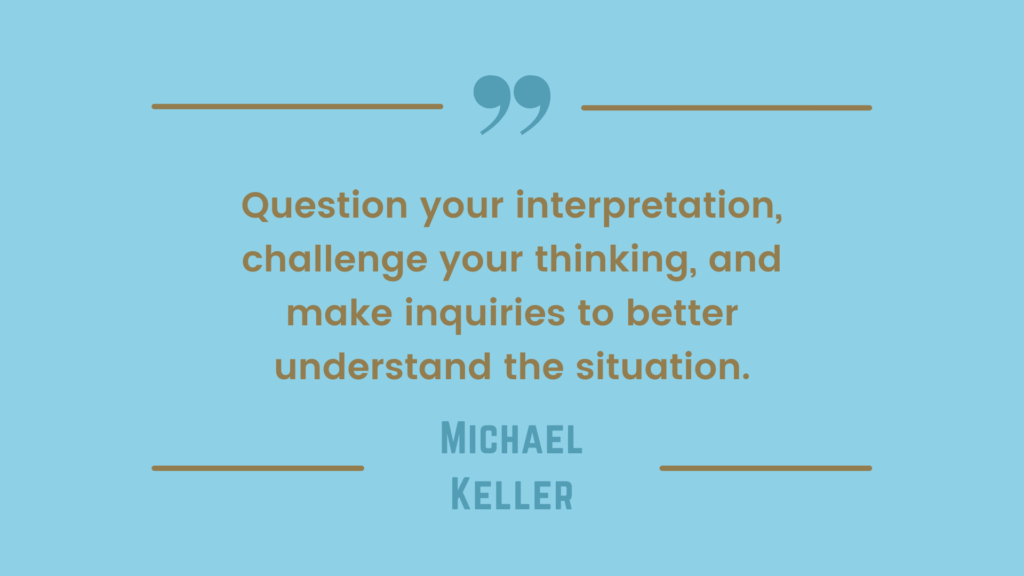The Power of Leadership Perception
Isn’t it amazing how quickly problems can arise due to a simple misunderstanding? In leadership, how we perceive situations and manage those perceptions can:
- shape outcomes
- influence team dynamics
- impact organizational success.
Perception is more than just observation—it’s interpretation, assumption, and reaction all rolled into one. Keep in mind that perceptions create one’s reality until proven otherwise.
The Impact of Leadership Perception: A Case Study
Consider these two scenarios:
Scenario One: The Downward Spiral of Misinterpretation
Taylor was a newly appointed VP at a mid-sized tech company. Upon stepping into her role, she sensed immediate tension in her team.
She interpreted the disengagement—heads down, doodling, lack of eye contact—as skepticism about her capabilities. Her nerves turned into frustration, triggering an instinctive response: to come in stronger.
“I need eyes on me. Okay, let’s get started,” she said sternly. The team responded with even more withdrawal. This set the tone for a strained leader-team relationship, all rooted in Taylor’s unchecked perceptions.

Scenario Two: The Power of Inquiry and Empathy
In the alternate version of the same story, Taylor acknowledged her nervousness but refused to be dictated by her assumptions. Rather than assuming her team doubted her, she tested her perception by engaging in open dialogue.
She shared her reasons for taking on the role and her vision for the team’s future, then invited them to share their concerns. Slowly, employees opened up: they feared leadership changes meant downsizing and layoffs.
By actively listening, Taylor diffused unnecessary anxiety, built trust, and set the foundation for a transparent, engaged culture.
Perception Drives Leadership Success
Perceptions influence our emotions, decisions, and interactions. In the first scenario, Taylor reacted based on an unverified assumption, leading to a counterproductive leadership approach. In the second scenario, she challenged her assumptions and embraced inquiry, leading to connection and trust.
Leaders must recognize the impact of their perceptions. It dictates whether we see obstacles or opportunities, collaboration or resistance, innovation or stagnation.
As Michael Keller, consultant and owner of Learning Inside Out, advises: “Question your interpretation, challenge your thinking, and make inquiries to better understand the situation.”

Shaping Leadership Perception: Practical Steps
Leadership perception is not just about how leaders see the world—it’s about how they shape the way their teams see the organization, their work, and their future.
Here are five strategic ways leaders can take charge of perception:
1. Monitor Your Thoughts
Perception begins internally. Recognize how your internal dialogue influences emotions and decisions. Pause and ask yourself:
- Am I interpreting this situation objectively, or am I reacting emotionally?
- What facts support my assumption?
- How would someone else view this situation?
Leaders who regulate their thoughts make better, more strategic decisions.
2. Challenge Assumptions Before Reacting
Conflicts often arise from untested beliefs. Before reacting, take a few deep breaths and assess:
- Is this belief based on concrete evidence?
- Are there perspectives I haven’t considered?
- What’s another possible explanation for what I’m perceiving?
This moment of reflection can prevent costly misjudgments and foster stronger team connections.
3. Reframe Setbacks as Opportunities
Perceptive leaders don’t just see challenges; they see pathways to growth. Instead of viewing setbacks as failures, ask:
- What lessons are learned in this situation?
- How can this challenge strengthen our strategy?
- What long-term opportunity is hidden at this moment?
This mindset shift turns adversity into a tool for resilience and innovation.
4. Lead with Clarity to Avoid Misunderstandings
Miscommunication breeds misperception. Successful and respected leaders:
- Provide clear expectations and reasoning.
- Align messaging across all levels of the organization.
- Foster an open dialogue where employees feel safe to seek clarity.
By leading with transparency, leaders prevent unnecessary confusion and cultivate trust.
5. Express Gratitude and Emphasize Learning
Every transition and challenge carries a lesson. Leaders who express gratitude for their teams’ efforts—even in times of uncertainty—create a culture of engagement and motivation. Ask yourself:
- Have I acknowledged my team’s contributions?
- How can I reinforce the positives amidst challenges?
- What long-term learning can I share from this experience?
By actively recognizing growth and effort, leaders shape an optimistic and resilient team culture.
Final Thoughts: The Narrative is Yours to Shape
As leaders, our perceptions don’t just shape our personal experiences—they define:
- the cultures we build
- the teams we nurture
- the outcomes we drive.
Whether managing a team, navigating an organizational shift, or handling personal challenges, the principle remains the same: Thoughts held in mind produce after their own kind.
Choose wisely, and watch how the narrative—and the outcomes—change in your favor.
Leadership perception is not just about what we see—it’s about how we choose to see it.
When leaders embrace this truth, they transform uncertainty into opportunity, misinterpretation into clarity, and resistance into alignment. The power is in your hands.
Karen has over 30 years of experience in organization development, specializing in performance improvement through consulting, facilitation, and training. A certified coach, she supports OD interventions by enhancing workplace relationships and building human capacity. Karen partners with stakeholders to drive change, improve practices, and foster organizational growth. With curiosity and compassion, she helps clients develop effective solutions to increase capacity and credibility while facilitating meaningful organizational change.

